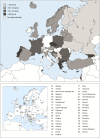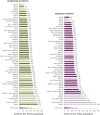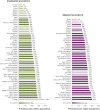The ERA-EDTA Registry Annual Report 2017: a summary
- PMID: 32897277
- PMCID: PMC7467580
- DOI: 10.1093/ckj/sfaa048
The ERA-EDTA Registry Annual Report 2017: a summary
Abstract
Background: This article presents a summary of the 2017 Annual Report of the European Renal Association-European Dialysis and Transplant Association (ERA-EDTA) Registry and describes the epidemiology of renal replacement therapy (RRT) for end-stage renal disease (ESRD) in 37 countries.
Methods: The ERA-EDTA Registry received individual patient data on patients undergoing RRT for ESRD in 2017 from 32 national or regional renal registries and aggregated data from 21 registries. The incidence and prevalence of RRT, kidney transplantation activity and survival probabilities of these patients were calculated.
Results: In 2017, the ERA-EDTA Registry covered a general population of 694 million people. The incidence of RRT for ESRD was 127 per million population (pmp), ranging from 37 pmp in Ukraine to 252 pmp in Greece. A total of 62% of patients were men, 52% were ≥65 years of age and 23% had diabetes mellitus as the primary renal disease. The treatment modality at the onset of RRT was haemodialysis for 85% of patients. On 31 December 2017, the prevalence of RRT was 854 pmp, ranging from 210 pmp in Ukraine to 1965 pmp in Portugal. The transplant rate in 2017 was 33 pmp, ranging from 3 pmp in Ukraine to 103 pmp in the Spanish region of Catalonia. For patients commencing RRT during 2008-12, the unadjusted 5-year patient survival probability for all RRT modalities combined was 50.8%.
Keywords: dialysis; end-stage renal disease; epidemiology; kidney transplantation; survival analysis.
© The Author(s) 2020. Published by Oxford University Press on behalf of ERA-EDTA.
Figures














References
-
- ERA-EDTA Registry. ERA-EDTA Registry Annual Report 2017. Amsterdam: Amsterdam UMC, Department of Medical Informatics, 2019
LinkOut - more resources
Full Text Sources

